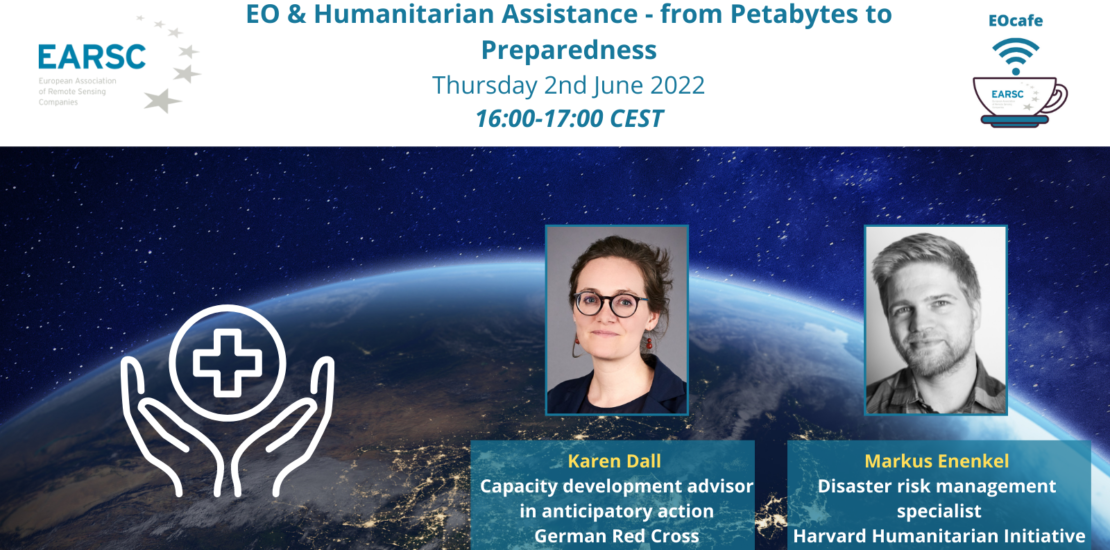- May 30, 2022
- Posted by: EARSC
- Category: EOcafe

EO & Humanitarian Assistance – from Petabytes to Preparedness
Thursday 2nd June 2022
16:00-17:00 CEST
Join us to learn how EO data is transforming the response to disasters, improving the provision of humanitarian assistance, and so helping save lives.
Background and Status-Quo
Satellite-derived information is already used in all phases of the disaster risk management cycle, ranging from risk mapping to emergency response and recovery/reconstruction. While Emergency Management Systems (EMS) like Copernicus EMS have been activated hundreds of times for rapid mapping to support emergency response, risk mapping activities are still comparably scarce. Still, several international humanitarian organisations have managed to complement existing emergency services by developing internal capacities to translate EO data into actionable information. In this context, the existence of a cloud-based infrastructure to store, process, visualize and share data, improving data quality as well as spatial and temporal resolution were a big and important step. There are incredible success stories, for instance EO-driven climate risk insurance, the monitoring of reconstruction activities via nighttime light assessments, or the generation of evidence for human rights violations. However, there is still a large gap between EO data-driven solutions that are technically or scientifically possible and the actual portfolio of humanitarian solutions.
Challenges
Humanitarian applications are gradually moving towards a convergence approach, meaning the combination of different, independent satellite-derived measurements (e.g. rainfall, soil moisture, NDVI) to decrease uncertainties in the monitoring of a specific hazard (e.g. drought). This approach is generally promising, but it requires end users to collaborate directly with data providers and/or analysts to understand the strengths and limitations of each dataset. Service providers, on the other hand, need to move away from selling a dataset or a product to highlighting the operational added-value from the perspective of the end user. Google’s value proposition is the most efficient search, not an algorithm. Apple’s value proposition is a lifestyle, not the technical specifications of a chip. EO data and service providers need to make the operational added-value for humanitarian applications as clear as possible, ideally by reverse-engineering solutions based on actual humanitarian needs and gaps.
Large-scale climate shocks, such as droughts, floods, or tropical storms, can lead to very heterogeneous impacts at the household level. Therefore, any kind of impact-based humanitarian instrument requires smart approaches to merge satellite-derived hazard data with socioeconomic information, such as vulnerability or coping capacities. While satellite data are usually standardized and harmonized, humanitarian assessments cannot be generated at the same frequency or, due to many organizations collecting different variables with different methods and at different times, at the same level of harmonization.
The Future of humanitarian EO
Without a doubt, humanitarian organisations have already begun to establish different communities of practice, both within and across organisations. One example is the EO for Anticipatory Action (EO4AA) working group of the Anticipation Hub, which is a platform hosted by the German Red Cross in cooperation with the International Federation of Red Cross and Red Crescent Societies (IFRC) and the Red Cross Red Crescent Climate Centre.
The EO4AA working group also opens the door to an entirely new generation of EO applications that support predictive analytics and the vital monitoring and evaluation processes. The latter is particularly important as anticipatory action mechanisms are aiming to protect around 1 billion people by 2025. Scaling up anticipatory action and risk financing will require more robust evidence – not only about the impact pathways of hazards, but about the pathways of humanitarian activities. Ultimately, humanitarian assistance is not only accountable to donors, but to vulnerable communities.
Upcoming humanitarian applications will focus much more on local risk ownership, locally-led approaches (e.g. participatory mapping) and data literacy (e.g. understanding what EO can and what it cannot do). This will require better links between EO, local knowledge and decision-making processes, efforts to boost EO data literacy, and advanced training data for pattern recognition. It is up to humanitarians to learn about the opportunities that EO can offer and up to the EO industry to understand humanitarian needs.
Join us our host Mr Geoff Sawyer (EARSC Strategic Advisor and former Secretary General) with Ms Karen Dall (Capacity development advisor in anticipatory action, German Red Cross) and Mr Markus Enenkel (Disaster risk management specialist, Harvard Humanitarian Initiative) to hear more about how EO data is transforming the response to disasters improving the provision of humanitarian assistance so helping to improve and save lives.
Topics which could be addressed during this EOcafe include the following:
- Integrating EO data into disaster risk management
- Which EO data can help in what situations
- How the EO data is transformed into operational information
- What future EO needs are emerging as a result of the increased application
- How industry can help with products and services to improve humanitarian assistance.
Registration: The webinar is open to ALL but priority will be given to EARSC members. Registration is free but compulsory. Please click on the following link to register.
Registration link
Please note this is a virtual event!
EOcafe is part of a series of EARSC meetings that offer timely, relevant, and practical information on a broad variety of topics related to the EO sector. Join us every two weeks to discuss and network while enjoying a cup of coffee with friends. You can watch all the previous EOcafes here.
IMPORTANT NOTES!!!
- The use of a video camera is not mandatory but encouraged to facilitate better interaction among the attendees and the guest speaker(s).
- The EOcafe will stay open after 17:00 in case our guests want to continue the discussion.
- By registering for this event, you accept the terms and conditions (https://earsc.org/wp-content/uploads/2021/03/EARSC_Events_GDPR.pdf).
If you have any questions, and/or you want to know more about the EOcafe, and/or you want to share an idea about a future EOcafe, please contact Natassa (Natassa.Antoniou@earsc.org).
